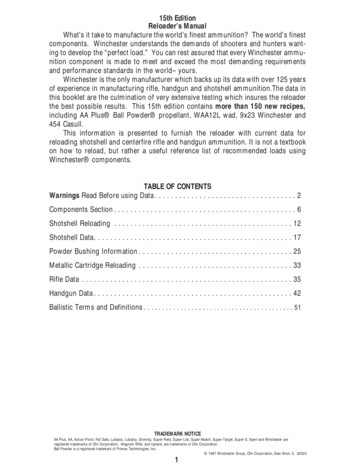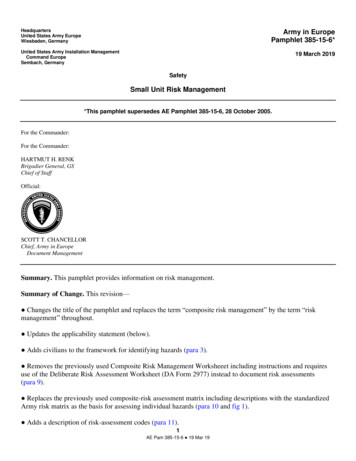
Transcription
eEdition7June2003
Table of Contents1.INTRODUCTION . 11.11.21.31.41.51.61.71.81.9PURPOSE. 1RESPONSIBLE CARE . 1BACKGROUND . 1WORKER/COMMUNITY ALERT . 2METHODOLOGY . 2DISCLAIMER . 2APPROVAL. 3REVISIONS. 3REPRODUCTION . 32.DEFINITIONS3.SYSTEM DESIGN . 73.13.23.33.4OBJECTIVE. 7SENSOR DISTRIBUTION . 7OPERATOR INTERFACE . 7OTHER CONSIDERATIONS . 84.CHLORINE MONITOR SELECTION . 84.14.24.34.44.54.6REQUIREMENTS/CAPABILITIES . 8MONITOR TYPES. 9SENSOR TECHNOLOGY . 10PRECISION AND ACCURACY. 12AMBIENT ENVIRONMENT . 13RELIABILITY . 145.INSTALLATION . 155.15.25.35.4SIGNAL TYPES . 15WIRING AND POWER SUPPLY . 16ENVIRONMENTAL CONSIDERATIONS . 16SENSOR PLACEMENT . 166.MAINTENANCE . 177.CALIBRATION . 188.RECOMMENDED EVALUATION PROCEDURE . 198.18.2CONSIDERATIONS . 20SELECTION CRITERIA . 209.REFERENCES AND ADDITIONAL SOURCE DOCUMENTS . 2110.APPENDICES . 2110.110.22002 CHLORINE MONITORING EQUIPMENT SURVEY . 212002- 2003 CHLORINE MONITORING EQUIPMENT MANUFACTURERS SURVEY . 22. 3
ATMOSPHERIC MONITORING EQUIPMENT FOR CHLORINE1.INTRODUCTION1.1Purpose1Edition 7 of Atmospheric Monitoring Equipment for Chlorine reflects modest changes to thispublication from Edition 6. This pamphlet provides information on the experiences ofChlorine Institute member companies in the design, installation, maintenance, and benefitsof ambient chlorine monitoring equipment. This information is basically unchanged fromEdition 6.The primary changes are information about chlorine monitoring equipment. This informationis presented in revised Appendices 10.1 and 10.2.Personal monitors are beyond the scope of this pamphlet.1.2Responsible CareThe Institute is an American Chemistry Council (ACC) Responsible Care PartnershipAssociation. In this capacity, the Institute is committed to: Fostering the adoption by itsmembers of the Codes of Management Practices; facilitating their implementation; andencouraging members to join the Responsible Care initiative directly.Chlorine Institute members who are not ACC members are encouraged to follow theelements of similar responsible care programs through other associations such as theNational Association of Chemical Distributors’ (NACD) Responsible Distribution Program orthe Canadian Chemical Manufacturers Association’s Responsible Care Program.1.3BackgroundAs of the publication date, there are no federal regulations within the United States whichmandate the installation of ambient chlorine monitors. However, state and local rules mayrequire the use of monitors for specific situations. Several non-domestic Chlorine Institutemember indicated in the survey that they have been required to install monitoring systems.Within the United States, the choice to install monitoring systems is an individual companyconsideration.The Environmental Protection Agency has recommended in its report to Congress "Reviewof Emergency Systems" (9.1), that industry be encouraged to conduct research to developand refine cost effective, reliable, chemical detection monitoring systems that do not requirefrequent calibration. During the Special Emphasis Program of 1986, the OccupationalSafety and Health Administration questioned chlorine manufactures concerning theiranticipated use of chlorine monitors for occupational safety.Additionally, facilities producing, using or otherwise handling chlorine may be affected byone or both OSHA's Process Safety Management Rule for Highly Hazardous Chemicals(PSM) (9.2) or EPA's Accidental Release Prevention Requirement; Risk ManagementPrograms (RMP) (9.3).
2PAMPHLET 73Depending on site-specific factors, the use of ambient chlorine monitors may assist thefacility in meeting the requirements of one or both of these regulations. The use of ambientchlorine monitors may also assist a facility in implementing security measures.1.4Worker/Community AlertChlorine monitors have proven to be effective leak detection devices. Many ChlorineInstitute members have installed perimeter systems, source systems or a combination of thetwo to provide early warning of leaks for plant personnel and the surrounding community.Although perimeter and source monitors are not intended to take place ofpersonal exposure monitoring, they can play a significant role in an overall plant safetyprogram. Early warnings of leaks may allow plant personnel to take appropriate safetyprecautions and to mitigate the chemical release. Data from source chlorine monitors alsomay be used in industrial hygiene programs to identify plant areas where additionalpersonnel exposure monitoring or engineering controls may be necessary.Early detection of chemical releases is also an extremely important part of any CommunityAwareness and Emergency Response (CAER) Program. Early discovery of chemicalreleases allows for prompt community notification and timely discussion of the appropriateemergency response. Information exchange between industry and the community is arequirement of the Emergency Planning and Community Right-to-Know Act, Title III of theSuperfund Amendments and Reauthorization Act (EPCRA). Perimeter and source chlorinemonitors may play an important role in a plant's personnel and community safety programs.1.5MethodologyThe Chlorine Monitoring Task Group, which developed Edition 5 of this pamphlet, surveyedmember companies of The Chlorine Institute. The 1990 survey attempted to summarizeexperiences with specific perimeter and/or source monitoring systems. It was not intendedto review or evaluate personnel monitors. The survey also asked for input which couldimprove existing monitoring systems.In mid-2002, Institute staff surveyed members to determine what chlorine monitors hadbeen installed since mid 1996. The results of this survey are shown in Appendix 10.1.Between mid 2002 and early 2003, Institute staff surveyed known chlorine monitoringequipment manufacturers. The search for manufacturers was extensive, but not exhaustive.Each was asked to provide characteristic system data in a standardized format as was donein previous editions. However, some manufacturers declined to provide information statingthat it was in danger of being outdated. Updated information could readily be provided bycontacting the manufacturer at its website address. In addition, several vendors declined torespond to the request. Accordingly, Appendix 10.2 has been modified to include onlyvendor address information. Readers of this pamphlet are reminded that there are mostlikely other manufacturers of such monitoring equipment.1.6DisclaimerThe information in this pamphlet is drawn from sources believed to be reliable. The Instituteand its members, jointly and severally, make no guarantee and assume no liability inconnection with any of this information. Moreover, it should not be assumed that everyacceptable procedure is included or that special circumstances may not warrant modified
ATMOSPHERIC MONITORING EQUIPMENT FOR CHLORINE3or additional procedure. The user should be aware that changing technology or regulationsmay require a change in the recommendations herein. Appropriate steps should be takento insure that the information is current when used. These recommendations should not beconfused with federal, state, provincial, municipal or insurance requirements, or withnational safety codes.1.7ApprovalThe Institute's Plant Operations and Safety Committee approved this pamphlet on April 15,2003.1.8RevisionsSuggestions for revisions should be directed to the Secretary of the Institute.1.9ReproductionThe contents of this pamphlet are not to be copied for publication, in whole or in part,without prior Institute permission.2.DEFINITIONSThe following are definitions of terms as used in this pamphlet.WordDefinitionAccuracyAbsolute correctness of the response of the analyzer.Alarm Only MonitorDetects the presence of chlorine and activates analarm if the concentration exceeds a preset limit.Ambient AirAtmospheric gas which chlorine analyzer monitors.AmperometricElectrolytic type sensor which uses counter andsensing electrodes to detect chlorine gas.Breathing ZoneThe height above a walking surface that personnel inthe area would obtain their air to breathe.CAERCommunity Awareness and Emergency ResponseProgram.CalibrationProcedure by which monitor is set for a knownconcentration to enable meaningful results.ChlorineChlorine as Cl2 and its oxyacid species; HOCl, ClO2,etc.Chlorine MonitoringSpring 1989 survey distributed to Chlorine Institute
4PAMPHLET 73Equipment Surveyofficial correspondents.ColorimetricMethod of analysis utilizing a colorimeter as thedetector.CoulometricMethodology which utilizes an initially fixed potentialapplied across electrodes in contact with a supportingelectrolyte to detect chlorine gas.CurrentFlow of electrons.Daisy ChainedA way of connecting transmitter or monitor wireswhich is similar to series wiring.DiffusionMovement of gas through a membrane, electrolyte,filter or other supporting medium.Dispersion ModelingTechnique used to determine desired locations ofchlorine sensors.Distributive Control SystemComputer system which uses outputs from monitorsto perform another function such as activate alarms,perform concentration calculations, etc.ElectrochemicalMethodology which uses an electrolyteelectrodes for the detection of chlorine.ElectrolyteUsually a saturated KBr, KCl, CaBr2 or KI solution inwhich electrodes are placed.EHCEnvironment and Health Committee of the ChlorineInstituteEPAUnited States Environmental Protection AgencyEPCRAEmergency Planning and Comments Right to KnowAct, Title III - Superfund Amendments andReauthorization Act (40 CFR355).Fixed Point MonitorChlorine monitor used to identify releases of chlorinegas at a predetermined location.Fluid Filled SensorElectrochemical type sensor using liquid electrolyte.Fugitive EmissionRelease of gas from a non-specific source such as aflange.Gel Filled SensorElectrochemical type sensor using gel electrolyte.Leak DetectionThe identification of a chlorine emission.and
ATMOSPHERIC MONITORING EQUIPMENT FOR CHLORINE5MicroprocessorA computer which evaluates outputs of chlorinemonitors and performs additional tasks with theoutput such as a volume calculation.Monitoring NetworkA system of sensors tied to a computer which mayinclude atmospheric monitoring device inputs,automatic concentration calculation outputs, etc.NCASIThe National Council of the Paper Industry for Air andStream Improvement, Inc.Negative InterferenceOhm's LawAn unwanted response of a chlorine monitor thatcauses the result to be lower than the actual value.Voltage current x resistance.OxidationLoss of electrons.OxidantPertaining to chlorine monitors: ozone, chlorinedioxide, fluorine, bromine, iodine, nitrogen oxide,nitrogen dioxide.OSHAUnited States Occupational Safety and HealthAdministration.PPMParts per million.Perimeter Chlorine MonitorChlorine detecting monitor with sensors locatedsurrounding a portion of or all of an operating plant.Personnel MonitorPersonnel Monitor Badge or pump type chlorinemonitor worn on a person to detect chlorine.PhotoelectricPOSCMethod of analysis utilizing a photoelectric detector.Plant Operations and Safety Committee of theChlorine Institute.Point SourceTerm used to describe a potential leak source whichis being monitored.Positive InterferenceAn unwanted response of a chlorine monitor thatcauses the result to be higher than the actual value.PotentiometricMethodology in which an electrode potential isdeveloped between ion sensitive electrodes.PrecisionRepeatability of the chlorine monitor response to thesame concentration of chlorine gas.
6PAMPHLET 73Preventive MaintenanceMaintenance performed on a routine schedule toincrease performance of a monitoring system.PASProperties, Analysis and Specification Support Groupof The Chlorine Institute.Qualitative CalibrationA test performed to ensure that the monitor respondsto chlorine gas.Quantitative CalibrationA procedure to relate the monitor response tochlorine gas concentration.ReductionGain of electrons.ReductantA chemical reagent capable of reducing chlorine,e.g., hydrogen sulfide, hydrogen chloride and sulfurdioxide.Relative HumidityThe ratio of the actual amount of water vapor presentin air to the maximum amount possible at the sametemperature.ReliabilityThe relative amount of time that a monitor operateswithout needing maintenance or calibration.ResistanceThat property of a material that opposes the flow ofelectric current.Sample PointMonitoring location of chlorine sensor.Self CheckingOption which allows monitor to verify its operation.SemiconductorNotably a proprietary metal oxide compound used insolid state chlorine sensors.SensorProbe or device which detects chlorine.Solid StateA type of metal-oxide semiconductor used for thedetection of chlorine.Source Chlorine MonitorChlorine monitor used to identify releases of chlorinegas from a particular source such as a valve, ventstack, etc.SpectrometricMethodology utilizing a spectrometer as the detector.Speed of ResponseThe time in which the sensor is first exposed tochlorine until it reaches 90% of its increase inresponse.
ATMOSPHERIC MONITORING EQUIPMENT FOR CHLORINE7Stack Gas MonitorA monitor used to detect chlorine concentrations in avent stack.Survey MonitorA portable instrument used to check chlorineconcentrations at specific locations.TransmitterDevice which sends an output to another devicewhere it may be monitored.VACVolts Alternating Current.VoltammetricMethodology which utilizes an applied fixed potentialacross two electrodes within an electrolyte for thedetection of chlorine.4-20 mA4 to 20 milliamp output from a chlorine monitor.3.SYSTEM DESIGN3.1ObjectiveAmbient chlorine monitoring systems, as used by Chlorine Institute member companies, aredesigned for the detection of leaks from fugitive emissions and point sources. Ambientchlorine detectors can identify releases to help protect operating personnel and thecommunity from chlorine exposure. Fixed area detectors are not intended to monitorpersonnel exposure nor to quantify leaks in the absence of other input.3.2Sensor DistributionAmbient chlorine detectors may be utilized either for perimeter monitoring or for monitoringat point sources. Many applications involve a combination of perimeter monitors and sourcemonitors. Perimeter monitors may be located using several methods which are detailed insection 5.4. The sensors are normally distributed around sources with the highest potentialfor emissions such as loading/unloading areas, compressors, or scrubbers. Perimetermonitors can give an indication of likely emission source locations when combined withmeteorological information about wind speed and direction. Ambient chlorine detectors arenot ordinarily utilized for in-stack monitoring, although some sensors may be suitable for thistype of application.3.3Operator InterfaceA chlorine monitoring system serves as an early warning device to facilitate decisionsconcerning leaks. It is not intended to, or even capable of, providing exact chlorineconcentrations during an incident. Although chlorine leaks often can be detected due toodor, plant workers may not always be immediately present in the area of a leak, and theodor threshold for people can vary greatly. A continuous monitoring system can assistoperating personnel by helping to identify an incident sooner.
8PAMPHLET 73Virtually all ambient chlorine monitoring systems set off alarms at control panels, indicatorsor distributive control system displays. Detected concentrations are ordinarily displayed foreach sensor. The indication of gas concentration may be as simple as a sequencer andmulti-point indicator or may involve a separate indicator for each point. Microprocessors areavailable that interface the sensor controllers to transmit video signals to color displaymonitors. Controller outputs can also be transmitted to printers or chart recorders.Complete microprocessor controlled continuous measurement systems are available whichcan record, alarm, time stamp and store data from each system. Indication and storagerequirements should be studied to select a system to meet present needs and futureexpansion.Several plants input monitoring data into a computer with dispersion modeling capabilities.Based on the chlorine concentrations and known meteorological data, the model canestimate the size of the release and predict the downwind impact. It is extremely importantfor users to understand the limitations and assumptions of the model. Some dispersionmodeling systems can be designed to provide backup capabilities for detection systems.An example output from a dispersion modeling system is presented in Figure 1.Clearly defined operator responses to problem identification are an important part of aneffective chlorine monitoring system. Monitoring program responsibilities are frequentlydivided among operating, management, and security personnel. The appropriate level ofinformation must be available to each group to allow informed and coordinated action. Anaction plan and training is an important consideration.3.4Other ConsiderationsOther relevant design considerations such as accessibility, ease of maintenance andcalibration, environmental conditions, specificity to chlorine, cost, and expansion potentialare discussed elsewhere in this pamphlet.4.CHLORINE MONITOR SELECTION4.1Requirements/CapabilitiesThe chlorine industry needs a low maintenance chlorine monitor that will provide arepeatable and reliable indication of the presence of chlorine in ambient air. The idealchlorine monitor would have the following features:a.highly specific to chlorineb.detects chlorine in nuisance ranges as well as indicates magnitude of largeexcursionsc.quick response and recovery timed.accurate and stable readingse.works in variable environmental conditionsf.self checking with minimal maintenance requirements
ATMOSPHERIC MONITORING EQUIPMENT FOR CHLORINEg.easily calibratedh.reasonable cost9At the present time, The Chlorine Institute ideal chlorine monitor does not exist for use in theplant environment. A continuous field monitor must operate in a wide variety ofenvironmental conditions. Because of the large number of different applications andrequirements, manufacturers must make compromises in the development of chlorinemonitors. The chlorine industry must evaluate the effects of these compromises in specificapplications. The number of unsuccessful installations serves as a warning to those whowould proceed without adequate planning. Consider the following examples:a.The non-specific monitorWhen demonstrated in the office, this monitor responded to chlorine. However,when installed in the field, the monitor also responded to interferences and theoperators soon lost confidence in the system and disregarded alarms.b.The high-maintenance monitorIn this case there was a commitment to a chlorine monitor and the system wasinstalled. Because calibration and maintenance were expensive and timeconsuming, the system was neglected and became unreliable.c.The no-maintenance monitorThis system was not supposed to require maintenance. However, this system wasnever tested. The system indicated no leaks, received no maintenance and did notgive false alarms. Unfortunately, the system also did not detect chlorine.It is encouraging to note the number of successful ambient chlorine monitoring installationswithin the industry as indicated by the results of the chlorine monitoring survey. Asuccessful system reliably detects and approximates the concentration of a chlorine emission. It also assists in the estimation of the duration of the emission. Combined withinformation from meteorological instruments, these data allow the rapid identification of thesource of the chlorine release.Chlorine monitoring installations are successful where the personnel responsible haveadequately defined their requirements and completed their evaluation. To completely definethe system requirements they should consider the accuracy required, the potentialinterferences, the ambient environment, the required reliability, and the means of calibrationin making their selection. Maintenance technicians input should be included in the testingphases whenever possible. An adequate level of testing and maintenance insures thecontinuing successful operation of the system.4.2Monitor TypesFour types of monitors are commonly used to detect chlorine in ambient air; the personnelmonitor, the survey monitor, the fixed point monitor, and the stack gas monitor. These arebriefly discussed below.
104.2.1PAMPHLET 73Personnel MonitorThe personnel monitor is designed to monitor an individual's exposure to chlorine during thecourse of a day. It is often worn with a shoulder strap or belt or even carried in a shirtpocket. This type of equipment is beyond the scope of this pamphlet.4.2.2Survey MonitorThe survey monitor is designed to be a portable instrument to check specific locations forthe presence of chlorine. The survey monitor could be used on a semi-permanent basis asa single point monitor during a specific task. This type of instrument is not suitable for afixed point system and is not considered in this pamphlet.4.2.3Fixed Point MonitorThe fixed point monitor is the primary choice for perimeter monitoring. It is designed to bepermanently located where ambient chlorine monitoring/alarming is desired. Fixed pointmonitors are available in single point and multi-point configurations and in alarm only andconcentration indicating types.The alarm only monitor is used to detect the presence of chlorine and activate an alarm ifthe concentration exceeds a preset limit. These units provide no indication of the concentration of chlorine present, only that it exceeds the set point. This type of device is quitecommon in single point installations and at user facilities with a small amount of chlorinehandling equipment. Alarm only monitors have limited value in a multi-point perimetermonitoring application as they give no indication about the concentration of chlorine present.The fixed point monitor type is the most commonly used for source and perimetermonitoring of chlorine. This monitor transmits an output proportional to the concentration ofchlorine detected.4.2.4Stack Gas MonitorThe stack gas monitor is used in stack gas applications. Due to the wide variety of stackconditions, these types of monitors are very application-specific. Many times an ambient airmonitor may be used in this service, but a detailed evaluation is required.4.3Sensor TechnologyChlorine sensor technology has been advancing on several fronts. The methodology usedby the sensors can be solid state, colorimetric, and electrochemical.4.3.1Solid State SensorsSolid state sensor technology uses a solid-state, continuous, diffusion type element. Aproprietary metal oxide semiconductor is located in the sensor circuit and acts as a resistor.When chlorine diffuses into the sensor, it is absorbed on the semiconductor causing itselectrical resistance to increase. This resistance change is proportional to the chlorineconcentration. When the chlorine disappears, the sensor returns to its original resistancelevel.
ATMOSPHERIC MONITORING EQUIPMENT FOR CHLORINE11This technology has been especially troubled by interfering gases, slow time to clear afterexposure and the need to recalibrate after a significant dose of chlorine. Since the solidstate sensor relies on the electrical characteristics of the metal oxide semiconductor,exposure to high concentrations of chlorine will corrode or permanently modify the semiconductor, therefore requiring recalibration for the new characteristics of the metal oxidesemiconductor.This solid state sensor technology holds the promise of being a very effective monitor if theproblems can be solved. The low maintenance requirements and long sensor lifetime areadvantages of this sensor. At the present time, its use for detecting chlorine has been verylimited. Respondent companies to The Chlorine Institute survey are not currently usingsolid state sensors.4.3.2Colorimetric SensorThe colorimetric technology uses a proprietary reagent which is exposed to chlorine. As aresult of this exposure, a stain or color change develops which is proportional to the concentration.This color change may be determined visually, photoelectrically orspectrometrically. This technology has limited usefulness in ambient chlorine source orperimeter monitoring because of the complexity of the hardware. It could be applied byusing a central instrument which would draw samples from many different locations within afacility. This would not give real time information or a continuous indication at each point.4.3.3Electrochemical SensorElectrochemical chlorine monitors are the most widely used and accepted of the availabletechnologies. This technology uses various forms of fluid filled or gel filled electrochemicalsensors. Electrochemical gas sensors are differentiated according to which parameter ofOhm's law is the dependent variable. Electrochemical sensors can be described asamperometric or potentiometric.The amperometric sensor utilizes an electrolyte solution or gel electrolyte with counter andsensing electrodes to detect chlorine gas. The electrolyte contains species capable ofbeing oxidized by chlorine (CaBr2, KC1, KBr or KI). A fixed potential (voltammetric) or aninitially fixed potential (coulometric) is applied across the electrodes in contact with theelectrolyte.When chlorine is present, it is reduced at the cathode and a current is generated. Thequantity of current is related to the concentration of oxidized species formed, and also to thechlorine gas concentration. This technique is termed amperometric, in that the amperagenecessary to reduce species oxidized by the anolyte constitutes the analytical signal.In potentiometric sensors, an electrode potential is developed between ion selectiveelectrodes. The potential
Qualitative Calibration A test performed to ensure that the monitor responds to chlorine gas. Quantitative Calibration A procedure to relate the monitor response to chlorine gas concentration. Reduction Gain of electrons. Reductant A chemical reagent capable of reducing chlorine, e.g., hydrogen sulfide, hydrogen chloride and sulfur










